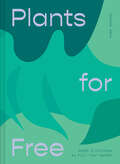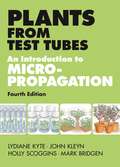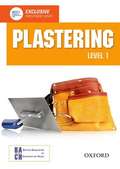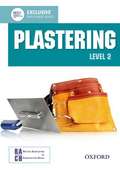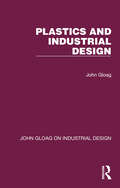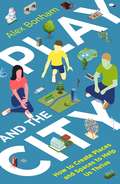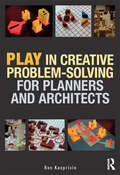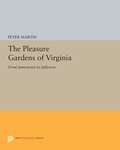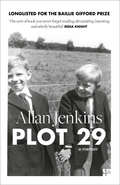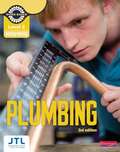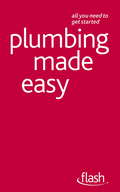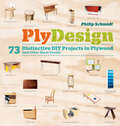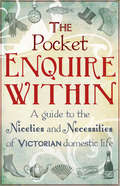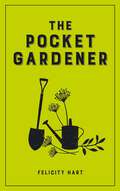- Table View
- List View
Plants for Free: Seeds And Cuttings To Fill Your Garden
by Sharon AmosIn this book, Sharon Amos explains how to design and create a beautiful garden for little or no money, offering tips on bartering for clippings, getting a bargain at garage sales or neighbourhood fairs, digging up suckers or adapting wild species and controlling them in a garden environment.
Plants for Soil Regeneration: An Illustrated Guide
by Sally Pinhey Margaret TebbsThis book is a comprehensive, beautifully illustrated colour guide to the plants which farmers, growers and gardeners can use to improve soil structure and restore fertility without the use and expense of agrichemicals. Information based on the latest research is given on how to use soil conditioning plants to avoid soil degradation, restore soil quality and help clean polluted land. There are 11 chapters: 1 to 6 cover soil health, nitrogen fixation, green manures and herbal leys, bacteria and other microorganisms, phytoremediators and soil mycorrhiza (plant-fungal symbiosis). Chapter 7 has plant illustrations, with climate range and soil types, along with their soil conditioning properties and each plant is presented with a comprehensive description opposite a detailed illustration, in full colour. Chapters 8 to 10 examine soil stabilisers, weeds and invasive plants, and hedges and trees and the final chapter, contains 5 case studies with the most recent data, followed by an appendix and glossary. The book allows the reader to identify the plants they need quickly and find the information necessary to begin implementation of soil regeneration.
Plants from Test Tubes: An Introduction to Micropropogation
by Lydiane Kyte John Kleyn Holly Scoggins Mark BridgenThirty years ago, in vitro propagation was a new technique for producing plants, and Lydiane Kyte’s Plants from Test Tubes became the standard work on the topic.The new fourth edition has been thoroughly revised and updated to reflect the many advances in science and technology, including the five accepted sequential stages of micropropagation. Ten new plants have been added. This in turn has greatly expanded the already extensive bibliography. Among the new topics that have been introduced or expanded on are embryo culture for breeding, somaclonal variation, anther culture, somatic embryogenesis, cryopreservation, and genetic engineering. More ornamental plant examples are given and many new illustrations provided, including a chronology of discoveries in micropropagation.
Plants of the World: An Illustrated Encyclopedia of Vascular Plants
by Maarten J. Christenhusz Michael F. Fay Mark W. ChasePlants of the World is the first book to systematically explore every vascular plant family on earth—more than four hundred and fifty of them—organized in a modern phylogenetic order. Detailed entries for each family include descriptions, distribution, evolutionary relationships, and fascinating information on economic uses of plants and etymology of their names. All entries are also copiously illustrated in full color with more than 2,500 stunning photographs. A collaboration among three celebrated botanists at the Royal Botanic Gardens, Kew, Plants of the World is authoritative, comprehensive, and beautiful. Covering everything from ferns to angiosperms, it will be an essential resource for practicing botanists, horticulturists, and nascent green thumbs alike.
Plants of the World: An Illustrated Encyclopedia of Vascular Plants
by Maarten J. Christenhusz Michael F. Fay Mark W. ChasePlants of the World is the first book to systematically explore every vascular plant family on earth—more than four hundred and fifty of them—organized in a modern phylogenetic order. Detailed entries for each family include descriptions, distribution, evolutionary relationships, and fascinating information on economic uses of plants and etymology of their names. All entries are also copiously illustrated in full color with more than 2,500 stunning photographs. A collaboration among three celebrated botanists at the Royal Botanic Gardens, Kew, Plants of the World is authoritative, comprehensive, and beautiful. Covering everything from ferns to angiosperms, it will be an essential resource for practicing botanists, horticulturists, and nascent green thumbs alike.
Plants with Style: A Plantsman's Choices for a Vibrant, 21st-Century Garden
by Kelly NorrisA fresh and exuberant guide to the best new ornamental plants handpicked by Kelly Norris, one of horticulture's brightest young stars.
Plasma Technology in the Preservation and Cleaning of Cultural Heritage Objects
by Radko Tiňo Katarína Vizárová František Krčma Milena Reháková Viera Jančovičová Zdenka KozákováScientists have long been looking for alternative methods for the cleaning of historical and cultural museum objects as conventional methods often fail to completely remove surface films, leaving contamination and surface residues behind. Low-temperature plasmas have recently been found to provide a new, efficient and durable approach that maintains the safety of both the materials and personnel. This book is the first to introduce the emerging use of low-temperature plasmas in the cleaning and decontamination of cultural heritage items. It provides a comprehensive exploration of the new possibilities of cleaning objects with plasma, before providing a practice guide to the individual cleaning methods and an overview of the technologies and conditions used in the different cleaning regimes. It is an ideal reference for researchers in plasma physics, in addition to professionals working in the field of historical and cultural conservation. Features: Provides a thorough overview of the cleaning potential of emerging plasma technologies in accessible language for professional restorers and conservators without a scientific background Includes the latest case studies from the field, which have not been published elsewhere yet Authored by a team of experts in the field
Plasma Technology in the Preservation and Cleaning of Cultural Heritage Objects
by Radko Tiňo Katarína Vizárová František Krčma Milena Reháková Viera Jančovičová Zdenka KozákováScientists have long been looking for alternative methods for the cleaning of historical and cultural museum objects as conventional methods often fail to completely remove surface films, leaving contamination and surface residues behind. Low-temperature plasmas have recently been found to provide a new, efficient and durable approach that maintains the safety of both the materials and personnel. This book is the first to introduce the emerging use of low-temperature plasmas in the cleaning and decontamination of cultural heritage items. It provides a comprehensive exploration of the new possibilities of cleaning objects with plasma, before providing a practice guide to the individual cleaning methods and an overview of the technologies and conditions used in the different cleaning regimes. It is an ideal reference for researchers in plasma physics, in addition to professionals working in the field of historical and cultural conservation. Features: Provides a thorough overview of the cleaning potential of emerging plasma technologies in accessible language for professional restorers and conservators without a scientific background Includes the latest case studies from the field, which have not been published elsewhere yet Authored by a team of experts in the field
Plastering Level 1 Diploma Student Book (NVQ Construction) (PDF)
by British Association of Construction HeadsWritten for the Cskills Awards Level 1 Diploma in Plastering, this book has been developed in partnership with the British Association of Construction Heads (BACH) to bring you up-to-date and expert knowledge of painting and decorating.
Plastering Level 2 Diploma Student Book (PDF)
by British Association of Construction HeadsThis book has been developed in partnership with the British Association of Construction Heads (BACH) to bring you up-to-date and expert knowledge of plastering.
Plastics and Industrial Design (John Gloag On Industrial Design Ser.)
by John GloagOriginally published in 1945, Plastics and Industrial Design is a non-technical work of reference for manufacturers and designers who, after the Second World War were beginning to realize the possibilities that manufacturing with Plastics could bring. The different types of plastics and their uses is discussed, as is their impact on the design of manufactured articles. Whilst the extensive use of plastic may have fallen out of favour in recent years due to environmental concerns, this book reminds us that in their infancy they offered exciting manufacturing possibilities.
Plastics and Industrial Design (John Gloag On Industrial Design Ser.)
by John GloagOriginally published in 1945, Plastics and Industrial Design is a non-technical work of reference for manufacturers and designers who, after the Second World War were beginning to realize the possibilities that manufacturing with Plastics could bring. The different types of plastics and their uses is discussed, as is their impact on the design of manufactured articles. Whilst the extensive use of plastic may have fallen out of favour in recent years due to environmental concerns, this book reminds us that in their infancy they offered exciting manufacturing possibilities.
Play and the City: How to Create Places and Spaces To Help Us Thrive
by Alex BonhamPlay is essential, for children but also adults. It's how we relax and revitalise ourselves, build and maintain friendships, try new things, learn and innovate.Cities have always been sites of play, bringing people together and pushing the boundaries of what is humanly possible. And now we need our cities to encourage and facilitate play of all kinds more than ever. If we want a world for our children to play in, we need to have a go at doing things differently. A city that is enjoyable to live in - that provides welcoming spaces, plentiful resources, and an attitude of 'yes, you can' - is a playful city. A city that is good for eight-year-olds as well as eighty-year-olds is a city that's good for all of us. By looking at how different cities across space and time have sought to encourage and facilitate play, Bonham shows us how to conceptualise our own contemporary city as a game, and encourages us to become participants rather than spectators.Play the city! Get involved, make a difference and help to bring your city back to life. There is help here to identify opportunities, build a team of friends and allies, take part - and win! It's time to make your move.
Play in Creative Problem-solving for Planners and Architects
by Ron KasprisinIn Play in Creative Problem-solving for Planners and Architects, "play" is defined, explored and demonstrated as a critical catalyst in creative problem-solving processes. The book defines the current psychological research into play and creative problem-solving, explores the necessary integration of the two, and exemplifies for students and practitioners the use of play in creative endeavors; and the role that play serves in separating linear from creative problem-solving approaches. Play is explored regarding its elements (tools, skills, environment), characteristics (a free activity without failure) and attitude as it relates to and activates the creative process with the focus on urban design, planning, architecture, and landscape architecture. The book re-establishes the whole mind-body thinking process of play as a means of object-learning; to provide designers and planners with alternative ways of design-thinking; and to challenge the over-utilization of digital technologies in creative processes. Creative problem-solving requires an appreciation for ambiguity, uncertainty of outcome, complexity that leads to the discovery of novelty and innovation. The book incorporates examples and exercises in play activities related to the design and planning fields, and exercises related to play-tools and skills for students and professionals. It also defines terms used in play and creativity psychology; provides examples and structure for play and creative problem-solving activities; describes the type and use of appropriate play-tools; contains an extensive bibliography on play and creative problem-solving texts; and provides significant illustrations making it fundamental reading for students and professionals in urban design and planning fields.
Play in Creative Problem-solving for Planners and Architects
by Ron KasprisinIn Play in Creative Problem-solving for Planners and Architects, "play" is defined, explored and demonstrated as a critical catalyst in creative problem-solving processes. The book defines the current psychological research into play and creative problem-solving, explores the necessary integration of the two, and exemplifies for students and practitioners the use of play in creative endeavors; and the role that play serves in separating linear from creative problem-solving approaches. Play is explored regarding its elements (tools, skills, environment), characteristics (a free activity without failure) and attitude as it relates to and activates the creative process with the focus on urban design, planning, architecture, and landscape architecture. The book re-establishes the whole mind-body thinking process of play as a means of object-learning; to provide designers and planners with alternative ways of design-thinking; and to challenge the over-utilization of digital technologies in creative processes. Creative problem-solving requires an appreciation for ambiguity, uncertainty of outcome, complexity that leads to the discovery of novelty and innovation. The book incorporates examples and exercises in play activities related to the design and planning fields, and exercises related to play-tools and skills for students and professionals. It also defines terms used in play and creativity psychology; provides examples and structure for play and creative problem-solving activities; describes the type and use of appropriate play-tools; contains an extensive bibliography on play and creative problem-solving texts; and provides significant illustrations making it fundamental reading for students and professionals in urban design and planning fields.
The Pleasure Gardens of Virginia: From Jamestown to Jefferson
by Peter MartinUsing a rich assortment of illustrations and biographical sketches, Peter Martin relates the experiences of colonial gardeners who shaped the natural beauty of Virginia's wilderness into varied displays of elegance. He shows that ornamental gardening was a scientific, aesthetic, and cultural enterprise that thoroughly engaged some of the leading figures of the period, including the British governors at Williamsburg and the great plantation owners George Washington, Thomas Jefferson, William Byrd, and John Custis. In presenting accounts of their gardening efforts, Martin reveals the intricacies of colonial garden design, plant searches, experimentation, and the problems in adapting European landscaping ideas to local climate. These writings also bring to life the social and commercial interaction between Williamsburg and the plantations, together with early American ideas about cultured living. While placing Virginia's gardening in the larger context of the colonial South, Martin tells a very human story of how this art both influenced and reflected the quality of colonial life. As Virginia grew economically and culturally, the garden became a projection of the gardener's personal identity, as exemplified by the endeavors of Washington and Jefferson at Mount Vernon and Monticello. In order to recapture the gardens as they existed in colonial times, Martin brings together paintings, drawings, and the findings of modern archaeological excavations.Originally published in 1991.The Princeton Legacy Library uses the latest print-on-demand technology to again make available previously out-of-print books from the distinguished backlist of Princeton University Press. These editions preserve the original texts of these important books while presenting them in durable paperback and hardcover editions. The goal of the Princeton Legacy Library is to vastly increase access to the rich scholarly heritage found in the thousands of books published by Princeton University Press since its founding in 1905.
Plot 29: A Love Affair With Land
by Allan Jenkins‘When I am disturbed, even angry, gardening has been a therapy. When I don't want to talk I turn to Plot 29, or to a wilder piece of land by a northern sea. There, among seeds and trees, my breathing slows; my heart rate too. My anxieties slip away.’
Plumbing Candidate Handbook: NVQ/SVQ Level 2 (PDF)
by Jtl TrainingTried and trusted Heinemann format breaks down theory into manageable sections, with accessible language so learners don t get bogged down.
Plumbing Made Easy: Plumbing Made Easy (Flash)
by Roy TreloarThe books in this bite-sized new series contain no complicated techniques or tricky materials, making them ideal for the busy, the time-pressured or the merely curious. Plumbing Made Easy is a short, simple and easy to follow guide to mastering some simple plumbing jobs that might occur on an everyday basis. By learning some basic skills and techniques you can learn how to carry out repairs and simple projects - in just 96 pages. Ideal for the busy or the thrifty, Plumbing Made Easy is a quick, to-the-point guide for those who want to complete simple plumbing jobs quickest time possible.
PlyDesign: 73 Distinctive DIY Projects in Plywood (and other sheet goods)
by Philip SchmidtMake sleek and functional home furnishings from inexpensive plywood and other off-the-shelf materials using only basic hand and power tools. This unique building guide offers 73 innovative ideas for using plywood to make everything from desks and workstations to children&’s playhouses. Projects for every need and skill level are presented with clear assembly diagrams, step-by-step instructions, and photos of the finished product. Discover the simplistic beauty plywood can bring to your next project and take pride in making your own handmade furniture.
The Pocket Book of Garden Experiments: Discover The Laboratory In Your Garden
by Helen PilcherWith more than 80 experiments for the whole family to discover and enjoy,The Pocket Book of Garden Experiments contains easy-to-follow instructions for activities that will stretch your imagination and bring out your inner scientist.x Make an ecosystem in a jarx Find out why leaves change colourx Turn potatoes into slimex Calculate the heights of treesx Make a sound map of your gardenEach experiment takes inspiration from the natural world and the fascinating things that live in it.
The Pocket Book of Garden Experiments
by Helen PilcherWith more than 80 experiments for the whole family to discover and enjoy,The Pocket Book of Garden Experiments contains easy-to-follow instructions for activities that will stretch your imagination and bring out your inner scientist.x Make an ecosystem in a jarx Find out why leaves change colourx Turn potatoes into slimex Calculate the heights of treesx Make a sound map of your gardenEach experiment takes inspiration from the natural world and the fascinating things that live in it.
The Pocket Enquire Within: A guide to the niceties and necessities of Victorian domestic life
by George ArmstrongWhat is the correct way to carve a partridge?How should leeches be applied?How can egg whites be used to repair broken china?First published in 1856, Enquire Within rapidly became the indispensable guide to Victorian domestic life. Packed with words of wisdom and pithy advice, it covered everything from entertaining and etiquette to household management, and took in considered discussion of such arcane matters as how singing might prevent consumption, and which ointments will remove freckles, not to mention why chess should on no account ever be played at a ball.This new, charmingly illustrated pocket-sized edition contains a selection of hints and tips that not only provide a fascinating insight into the day-to-day life of Victorian Britain, but also, in places, reveal timeless wisdom that we would do well to heed today.
The Pocket Gardener
by Felicity HartBrimming with curious garden lore as well as practical, year-round advice on everything from planting and pruning to growing your own veg and composting, this handy book is the perfect companion for any gardener. Whether you’re seeking inspiration or information, The Pocket Gardener will keep you busy in all seasons.
Pocket Guide To The Edible Garden: What to Do and When, Month by Month
by Joe HashmanThe Pocket Guide to the Edible Garden takes its readers through the fruit and vegetable gardening year, listing month-by-month the tasks to be done and showing in original hand-drawn illustrations exactly how to do them. It answers those awkward but essential questions regarding how deep, how far apart, how to tend and care, and how - and when - to do this and that. This handy book is a practical manual that wants to spend most of its life in your pocket or in the garden shed, and to be consulted regularly throughout the seasons, just as you might turn to an experienced old friend for guidance and advice on edible gardening matters. The Pocket Guide to the Edible Garden holds in its pages the knowledge and the experience of author Joe Hashman (aka 'Dirty Nails' of the Blackmore Vale Magazine) condensed into clear, concise language and amplified by Helen Lanchbery's meticulous drawings.Contents: Background; Introduction; How to use this book; Understanding proprietary growing media; Green manures; JANUARY; General jobs to do; Leaves & greens; Roots, tubers and stems; Veg fruit; Onion tribe; Peas & beans; Edible flowers; Fruit garden; FEBRUARY; General jobs to do; Leaves & greens; Roots, tubers and stems; Veg fruit; Onion tribe; Peas & beans; Edible flowers; Fruit garden; MARCH; General jobs to do; Leaves & greens; Roots, tubers and stems; Veg fruit; Onion tribe; Peas & beans; Edible flowers; Fruit garden; APRIL; General jobs to do; Leaves & greens; Roots, tubers and stems; Veg fruit; Onion tribe; Peas & beans; Edible flowers; Cereals; Fruit garden; MAY; General jobs to do; Leaves & greens; Roots, tubers and stems; Veg fruit; Onion tribe; Peas & beans; Edible flowers; Cereals; Fruit garden; JUNE; General jobs to do; Leaves & greens; Roots, tubers and stems; Veg fruit; Onion tribe; Peas & beans; Edible flowers; Cereals; Fruit garden; JULY; General jobs to do; Leaves & greens; Roots, tubers and stems; Veg fruit; Onion tribe; Peas & beans; Edible flowers; Cereals; Fruit garden; AUGUST; General jobs to do; Leaves & greens; Roots, tubers and stems; Veg fruit; Onion tribe; Peas & beans; Edible flowers; Cereals; Fruit garden; SEPTEMBER; General jobs to do; Leaves & greens; Roots, tubers and stems; Veg fruit; Onion tribe; Peas & beans; Edible flowers; Cereals; Fruit garden; OCTOBER; General jobs to do; Leaves & greens; Roots, tubers and stems; Veg fruit; Onion tribe; Peas & beans; Edible flowers; Fruit garden; NOVEMBER; General jobs to do; Leaves & greens; Roots, tubers and stems; Onion tribe; Peas & beans; Edible flowers; Fruit garden; DECEMBER; General jobs to do; Leaves & greens; Roots, tubers and stems; Veg fruit; Onion tribe; Peas & beans; Edible flowers; Fruit garden; INDEX.
